Superman: The Movie Blu-ray Movie 
Extended TV Cut & Special EditionWarner Bros. | 1978 | 1 Movie, 2 Cuts | 189 min | Not rated | Oct 03, 2017
Movie rating
|
| 8.1 | / 10 |
Blu-ray rating
| Users | 4.0 | |
| Reviewer | 3.5 | |
| Overall | 3.5 |
Overview click to collapse contents
Superman: The Movie (1978)
The enduring adventure spanning the Man of Steel's life, from his Krypton infancy and Midwest boyhood to his career as Daily Planet reporter Clark Kent, and through his titanic struggle with archnemesis Lex Luthor.
| Action | 100% |
| Adventure | 89% |
| Sci-Fi | 80% |
| Comic book | 73% |
| Fantasy | 57% |
Specifications click to expand contents
Video
Video codec: MPEG-4 AVC
Video resolution: 1080p
Aspect ratio: 2.40:1
Original aspect ratio: 2.39:1
Audio
See individual releases
Subtitles
None
Discs
Blu-ray Disc
Two-disc set (2 BDs)
Playback
Region free
Review click to expand contents
Rating summary
| Movie | 4.0 | |
| Video | 4.0 | |
| Audio | 3.5 | |
| Extras | 0.0 | |
| Overall | 3.5 |
Superman: The Movie Blu-ray Movie Review
Too Much Man of Steel?
Reviewed by Michael Reuben October 3, 2017Richard Donner's Superman: The Movie
exists in multiple
versions. The version released to
theaters in December 1978 was the result of a production process riven by conflict that would
eventually lead to Donner being fired from Superman II
by producers Alexander and Ilya
Salkind. This 143-minute theatrical cut remained the version most widely seen for the remainder
of the 20th Century. It was released on home video in multiple forms and grew more beloved
with each passing year, despite some rough edges. These included hastily completed effects, a
rough sound mix and inconsistent color timing that made the Man of Steel an unintentional
chameleon, with a uniform that changed shades and hues from one shot to the next. Sometimes it
was blue; sometimes it was almost green.
In 2000, Donner and Warner Brothers collaborated on a director's
cut of Superman, utilizing
then-new digital technology to address many of the film's shortcomings—but they also incurred
the wrath of long-time fans for whom the original's flaws had become old friends. Especially
controversial was the new 5.1 sound mix with newly recorded effects and a surround field far
more active than anything of which 1978 stereo was capable.
Donner also added back numerous deleted scenes, some of which extended the story while others
were nods to franchise afficionados, like the appearance of a childhood Lois Lane with her
mother played by Noel Neill, who was Lois in the Fifties Superman TV series. (Donner also
reinserted his own cameo as a passerby who tells Christopher Reeve's Clark Kent: "That'll be the
day, when a man can fly!") Despite the protests of theatrical cut loyalists, Donner's director's cut
(a/k/a the "Special Edition") has been treated as the standard version of Superman ever since. It
was the version that Warner released on Blu-ray in
2006 at the dawn of the format and has been
reissued in multiple forms since then. Warner did eventually make the theatrical cut available on
Blu-ray, but only as part of the Superman Motion Picture Anthology released in 2011. (The
anthology is scheduled for re-release
this month as part of a wave of DC reissues promoting the
upcoming Justice League.)
But there's another, even longer version of Superman that has attained legendary proportions,
mostly because of its rarity. In the early Eighties, producers Alexander and Ilya Salkind created
an "Extended Cut" for TV, adding back every available trim and outtake and charging
broadcasters around the world by the minute to extract maximum revenue from the property.
ABC ran a 182-minute version of the film in 1982, split in half as a two-night event.
International stations ran the Salkinds' full 188-minute cut, and it eventually played on station
KCOP in Los Angeles. Tapings of these broadcasts have circulated for years in bootleg
videotaped copies, commanding high prices from fans eager to enjoy every available minute of
Superman footage.
For many years, it was assumed that the Salkinds' Extended Cut existed only in the form of a
pan-and-scan 1.33:1 standard definition video master prepared for broadcast. But then one of
those surprise discoveries occurred that sometimes happens in a massive archive like Warner's: a
complete film source of the Extended Cut in Superman's original widescreen aspect ratio. (More on that
in the "Video" section below.) After a substantial restoration effort, this long-sought-after version
of the film is being released on Blu-ray by the Warner Archive Collection, paired with a copy of
Richard Donner's Special Edition. The Special Edition is the remastered disc first seen in the 2011 Superman Motion Picture
Anthology.
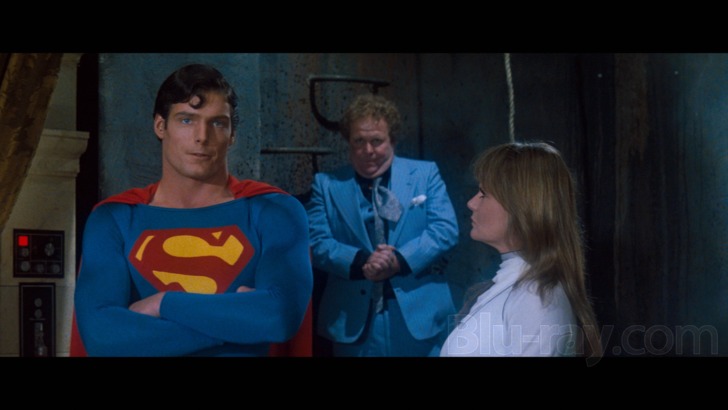
Feature discussions of Superman can be found in the site's original 2006 review by Greg Maltz as well as the Anthology review by Kenneth Brown. My colleague Josh Katz provides a suitable introduction in his weekly column, observing that:
Superman is as joyous and affirming a blockbuster adventure as the latest Pirates of the Caribbean is dispiriting and bland. Nowadays, it's hard to imagine a time when comic-book movies didn't dominate the theatrical landscape, but it was Donner who legitimized the genre in ways no one had imagined. . . . Donner's true masterstroke [was] casting a young, virtually unknown Christopher Reeve as adult Clark Kent/Superman. . . . We're looking at a movie star, period, and the definitive live-action interpretation of the character.
The Salkind's Extended Cut is 45 minutes longer than Superman's original cut, but that figure is misleading, because about a third of the new material has already appeared with Donner's Special Edition. The Special Edition Blu-ray helpfully assembles all of the scenes that Donner added back in an extra captioned "Restored Scenes", and it includes another extra called "Additional Scenes" with a deleted subplot depicting the pit of wild animals kept by Gene Hackman's Lex Luthor in his underground lair. An early scene shows Ned Beatty's hapless henchman, Otis, fearfully feeding the beasts (which are never shown), and a later one has Luthor preparing to feed them his mistress, Miss Teschmacher (Valerie Perrine), after her betrayal has foiled his plans. She is saved by Superman, just before he takes Lex and Otis to jail, whereas in the theatrical cut and the Special Edition, we go straight from Superman flying away from Lois Lane (Margot Kidder) in the desert to his depositing Lex and Otis in the penitentiary yard. Donner chose not to add back this subplot, but the Extended Cut includes it.
The footage beyond the scenes excerpted in the Special Edition's extras is spread throughout the Extended Cut. A scene by scene accounting is beyond the scope of this review, but the following example will serve as an illustration. In the sequence where Lex and his cohorts intercept and reprogram the first of two nuclear-tipped ICBMs, they divert the military convoy by crashing a remote-controlled car. In both the theatrical cut and the Special Edition, Lex is the only one operating the controls, but the Extended Cut starts the scene with Otis manning the remote ineptly so that the car weaves all over the highway, until Lex seizes control. ("Are you in England?" he sneers at Otis. "Why are you driving on the left side?"). Miss Teschmacher joins them, and further dialog ensues. After the convoy stops and the soldiers cluster around Miss Teschmacher lying on the ground faking injury, Lex pulls up in an ambulance and asks: "Somebody hurt?" The scene used to end there, but the Extended Cut continues with further exchanges between Lex and the soldiers and then between Lex and his mistress on the ground. Finally, when Otis rejoins the gang in the ambulance and realizes that he entered the wrong coordinates, the scene used to end with Lex jumping into the back seat to attack him. In the Extended Cut, the attack continues with Lex pounding on Otis while Miss Teschmacher screams, grabs the wheel and hustles into the driver's seat. Later, Otis is seen with his face badly bruised, as the team pauses to recover.
Note that none of these extensions add anything new to the plot. Depending on one's inclinations, they could be viewed as an entertaining expansion of the comic byplay among the film's villains or as narrative bloat at a point where the story needs to progress as fast as possible. Original editor Stuart Baird obviously took the latter approach, as did the team that worked with Donner on the Special Edition. The Salkinds chose differently.
Scene extensions of this nature occur throughout the film, and opinions will vary on whether each one is an improvement or a distraction. But it's hard to dispute that the cumulative effect is to slow the pacing to a crawl, which is a risky proposition in a film already straining under a massive weight of back story. Superman remains a charming and memorable entertainment, but it's also one of the longest prologues in film history. So much is devoted to setting up Superman II's romance with Lois and its battle with Terence Stamp's General Zod that the first film barely has room for its own self-contained tale. The additional scenes in the Extended Cut don't add to that story; they just make it take longer.
Blu-ray.com's previous reviews ranked Superman: The Movie at 4/5. I agree with that score and have retained it, despite my belief that the Extended Cut would deserve a lower rating if it were evaluated on its own merits. But that would be a meaningless evaluation. Whatever its flaws or virtues, the Extended Cut can't exist in a vacuum. Think of it as a three-hour "extra" to a classic whose merits have long since been well established.
Superman: The Movie Blu-ray Movie, Video Quality 
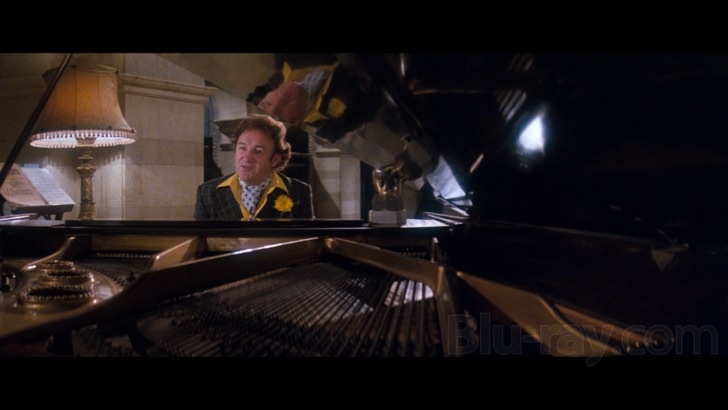
Superman was shot by the eminent British cinematographer Geoffrey Unsworth, the DP of 2001
and Cabaret, who didn't live
to see the film's
release, dying of a heart attack in October 1978.
The film is dedicated to his memory. The Extended Cut was created by the film's producers
without any participation by the studio or the director, and until recently it was assumed to exist
only in a cropped 1.33:1 NTSC master for broadcast. The discovery of a source suitable for Blu-ray occurred when WAC noticed
an odd entry in
Warner's massive catalog: nineteen reels of film
marked "Superman; TV version" with no further technical specifications. When the film cans
were pulled from the warehouse, opened and examined, they were found to contain a complete
interpositive of the Extended Cut, which Warner's Motion Picture Imaging facility proceeded to
scan at 2K.
Color correction of the Extended Cut presented unusual challenges. No records have survived of
what sources the producers used for their version's various constituents, and no answer print or
other uniform reference exists. As with the original theatrical prints, color, clarity and densities
varied wildly from shot to shot, and the interpolation of new material only served to amplify the
problem. Using the Donner Special Edition as a guide, MPI worked to smooth out transitions
from scene to scene and preserve consistent color in such key visual elements as Superman's red,
white and blue uniform. Several months of work were devoted to creating a watchable
experience without jarring shifts in quality. MPI even performed what would normally be
considered digital effects work to remove cables that were still visible in some of the added
flying shots (which were probably hidden for broadcast by low resolution and/or panning-and-scanning).
The result is an impressive technical presentation that effectively erases all traces of the Extended
Cut's random assembly. Whatever qualms one may have about the dramatic value of the
producers' additions, their visual presentation is smooth and undistracting, and MPI appears to
have accomplished this massaging of elements without taking such shortcuts as grain reduction
or digital sharpening. The colors of Superman's uniform are brightly consistent throughout, as
are other critical elements (the reds of Krypton and its destruction, the blues of Earth's sky, the
greenery of the Kent farm, the cement grays of Metropolis). MPI's work is so good that I had to
switch back and forth between the Extended Cut and the Special Edition in order to be certain
which scenes were exclusive to the former. While the disc may not contain the definitive version
of Superman, it surely offers the definitive presentation of the Extended Cut.
Switching back and forth between the two cuts also reveals meaningful differences in contrast,
color timing and, on occasion, framing, as well as a more pronounced grain texture in the
Extended Cut. WAC is well aware of these issues, which are consistent with the unknown
provenance of the Extended Cut's elements. While MPI did use Donner's Special Edition as a
reference, it has not attempted to reformulate the Extended Cut to ape the approach of Donner
and his restoration team. For better or worse, the Extended Cut is its own creature, in both editing
and visual presentation.
At over three hours, Superman's Extended Cut is too long for WAC to maintain their usual high
average bitrate in the mid-thirties, but the disc's average of 28.84 is still generous, and the
encode has been capably performed.
How does one assign a video score to something like the Extended Cut, where the source
material is less than ideal and the accuracy of the end product can only be surmised? I'm giving it a
high mark to acknowledge the success of WAC's and MPI's efforts to create a coherent visual
experience from a problematic source. Some fans may even prefer this color timing to that of the
Special Edition, which was widely criticized for revisionism. In the accompanying screenshots, I
have attempted to offer comparisons between the two versions, with the usual disclaimer that
Blu-ray.com's capture process does not provide for precise frame matches. Screenshots 8
through 35 present alternating shots from the Extended Cut and the remastered Special Edition
(in that order) to provide some illustration of the differences. The Extended Cut's image is always first, followed by
the corresponding
image from the Special Edition.
Superman: The Movie Blu-ray Movie, Audio Quality 
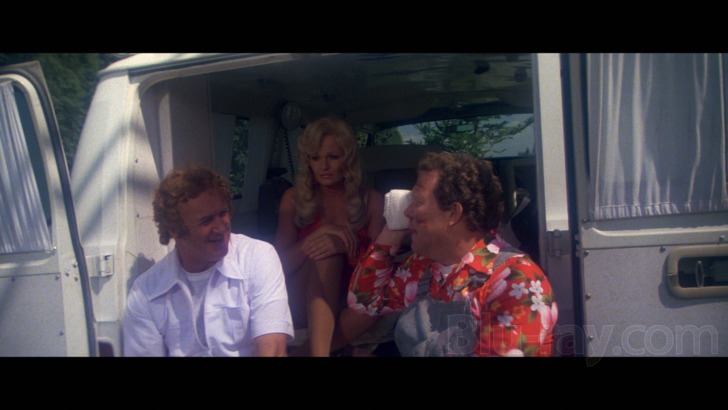
Because the Extended Cut was intended for TV broadcast in the early Eighties, only a mono mix
was created. WAC has taken that mix from the interpostive's optical track, cleaned it of any age-related damage and distortion
and encoded it as
lossless DTS-HD MA 2.0. WAC describes their
treatment as "enhanced mono", which involves using re-EQ and other small sonic adjustments to
differentiate the left and right channels and create a greater sense of space. For best results, I
recommend playing this track through the main front speakers, without applying any form of
Prologic decoding or DSP processing. In general, the track has acceptable fidelity, clear dialogue
and effects, and a clean reproduction of John Williams' score, though with less dynamic range
and sonic impact than the Special Edition's 5.1 remix.
For the beginning and end titles, WAC has borrowed the stereo track from the theatrical edition,
so that those sequences are true stereo, and you can hear the difference. The transition from
stereo to mono, and then back to stereo at the end, has been neatly finessed. Purely as an audio
experience, the Extended Cut isn't especially impressive, but it deserves high marks for its
treatment of the source.
Superman: The Movie Blu-ray Movie, Special Features and Extras 
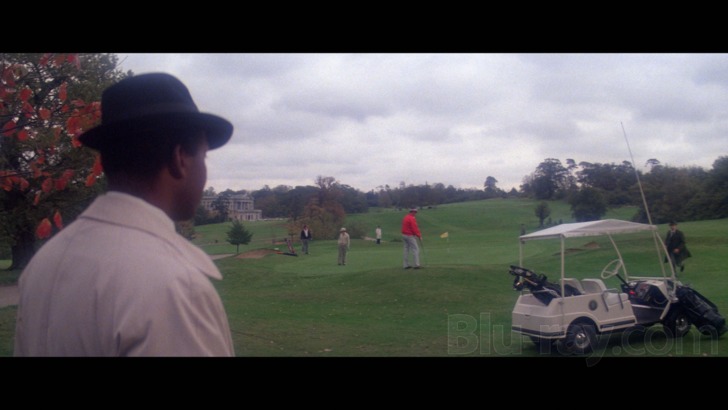
The Extended Cut has no extras. The included Special Edition disc has the extras previously listed here under "Disc 2".
Superman: The Movie Blu-ray Movie, Overall Score and Recommendation 
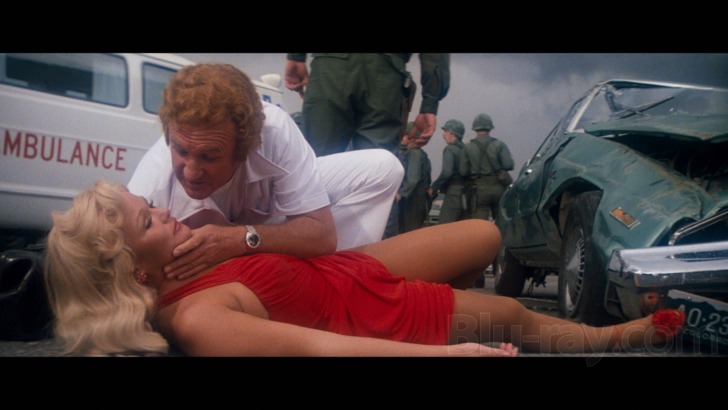
Much of the appeal of Superman's Extended Cut was eliminated by Donner's 2000 Special
Edition, which restored the most important plot enhancements that, before then, had only been
seen on TV (e.g., the opening confrontation between Jor-El and Krypton's council and their
attempt to arrest him before he can send his son to earth). Donner and the restoration team knew
what to put back for the story's sake and what to leave out. Their goal was to improve the movie,
whereas the Salkinds' choices were driven by how much they could charge ABC and other stations for
each additional minute. With WAC's new Blu-ray, fans can now compare, contrast and decide
for themselves. The only losers in this deal are those who paid a premium for videotaped
versions of a cropped TV broadcast, because all such recordings have just been rendered
worthless. Recommended on its technical merits, but it's not the version I'll watch in the future.





























